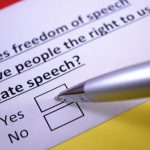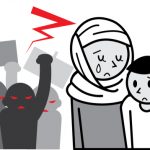Is Hate Speech a Crime in Australia?

The perceived tension between free speech and hate speech is a topic of significant controversy and heated debate.
Whereas proponents of unfettered free speech argue that a tenet of a healthy, functioning democracy is the freedom to express oneself however one wishes, those in favour of laws which restrict that ‘freedom’ point to the fact that limitations have long been placed on it – from laws against defamation, to those against directly inciting crimes upon others such as acts of terrorism, to offensive language laws.
The internet is full of quotations which attempt to explain or discern between the two concepts:
- ‘Freedom of speech is not a licence to abuse’,
- ‘There is a fine line between free speech and hate speech. Free speech encourages debate whereas hate speech incites violence’,
- ‘Hate speech is not free speech. Every time hate speech is permitted it costs someone part of his or her self respect, or part of their sanity’,
- ‘Some people’s idea of free speech is that they are free to say what they like, but if anyone says anything back, that is an outrage’;
To list just a few.
But what does the law say about hate speech in Australia, and can it amount to a criminal offence?
Section 18C of the Racial Discrimination Act 1975 (Cth)
In the mid-1990s, the federal Labor government inserted section 18C into the Racial Discrimination Act 1975.
The section makes it unlawful for a person to do a public act that is reasonably likely, in all the circumstances, to offend, insult, humiliate or intimidate another person or group because of their race, colour or national or ethnic origin.
The section make clear that a public act can include:
- Causing words, sounds, images or writing to be communicated to the public,
- Acts done in a public place, and
- Acts done in sight or hearing of people in a public place.
A ‘public place’ is defined as any place to which the public have access as of right or by invitation, whether express or implied and whether or not a charge is made for admission.
Section 18B makes clear that is an act may be unlawful if it is done for two more reasons, as long as one of those reasons is the race, colour or national or ethnic origin of the other person or group.
Complaints under section 18C can be made to the Human Rights Commission, which has limited powers including the ability or conduct investigations and conciliations.
According to the Commission’s website, ‘[c]omplaint outcomes can include an apology, reinstatement to a job, compensation for lost wages, changes to a policy or developing and promoting anti-discrimination policies.’
Section 18D: Exemptions
Section 18D of the Act provides that section 18C does not unlawful anything said or done reasonably and in good faith:
- in the performance, exhibition or distribution of an artistic work; or
- in the course of any statement, publication, discussion or debate made or held for any genuine academic, artistic or scientific purpose or any other genuine purpose in the public interest; or
- in making or publishing:
- a fair and accurate report of any event or matter of public interest; or
- a fair comment on any event or matter of public interest if the comment is an expression of a genuine belief held by the person making the comment.
The exemptions are clearly broad and operate to defeat a large number of complaints.
Findings of racial vilification are rare
Perhaps partly due to the breadth of exemptions and limited powers of the Human Rights Commission, positive findings of racial vilification have been few and far between.
In 2000, the Commission found that German-born Australian Frederick Toben had racially vilified Jews by publishing on his website that the Holocaust had never occurred, while in 2011 a Federal Court Judge found that conservative commentator Andrew Bolt had racially vilified Indigenous people by suggesting that those of “fair skin” were exploiting the system.
The judge in that case found that, “I am satisfied that fair-skinned Aboriginal people (or some of them) were reasonably likely … to have been offended, insulted, humiliated or intimidated by the imputations conveyed by the newspaper articles”.
Coalition’s attempts to dilute the law
The federal Coalition government attempted in both 2014 and 2017 to replace the words “offend” and “insult” in section 18C with the word “harass”; with Attorney-General George Brandis famously stating that “people have a right to be bigots”.
However, the section has survived and provides a limited avenue of complaint and redress for those who have been subjected to racial vilification.
That being so, section 26 of the Act makes clear that an adverse finding under section 18C does not amount to an offence.
So the question remains, can hate speech amount to a crime in Australia?
Commonwealth law: Inciting a crime
Section 11.4 of the Criminal Code Act 1995 (Cth) contains the general offence of ‘incitement’, which provides that:
‘A person who urges the commission of an offence commits the offence of incitement.’
The section goes on to states that:
- A person may be found guilty even if committing the offence incited is impossible,
- Any defences, procedures, limitations or qualifying provisions that apply to an offence apply also to the offence of incitement in respect of that offence, and
- Any special liability provisions that apply to an offence apply also to the offence of incitement in respect of that offence.
This ‘catch-all’-type provision means that a person can be found guilty of a particular offence under Criminal Code Act – which applies across Australia – if they encourage another person to commit that particular offence.
So, for example, if a person encourages another to commit the offence of intentionally causing serious harm to an Australian citizen or resident under section 115.3 of the Act, he or she may be found guilty of that offence – whether or not the encouragement is due to the person’s beliefs or characteristics.
The offence is not applicable to attempts or conspiracies, and the penalties that apply are:
- 10 years in prison for offences punishable by life imprisonment,
- 7 years in prison for offences punishable by 14 years’ imprisonment or more,
- 5 years in prison for offences punishable by at least 10 years’ but less than 14 years’ imprisonment,
- 3 years or the maximum penalty, whichever is less, for offences otherwise punishable by a term of imprisonment, or
- the maximum applicable fine if the offence is not punishable by a term of imprisonment.
Commonwealth law: urging violence against members of groups
In addition to the law against incitement, section 80.2(1) of the Criminal Code prescribes a maximum penalty of 7 years in prison for urging violence against members of groups.
The section provides that:
A person (the first person) commits an offence if:
(a) the first person intentionally urges another person, or a group, to use force or violence against a person (the targeted person); and
(b) the first person does so intending that force or violence will occur; and
(c) the first person does so because of his or her belief that the targeted person is a member of a group (the targeted group); and
(d) the targeted group is distinguished by race, religion, nationality, national or ethnic origin or political opinion; and
(e) the use of the force or violence would threaten the peace, order and good government of the Commonwealth.
Section 80.2(2) prescribes a 5 year maximum penalty where subsection (d) above is not established.
NSW Criminal Law: Publicly threatening or inciting violence against persons or groups
On 21 June 2018, the New South Wales Parliament passed the Crimes Amendment (Publicly Threatening and Inciting Violence) Bill, which inserted a new section 93Z into the Crimes Act 1900.
That section is the offence publicly threatening or inciting violence against a person or group, which carries a maximum penalty of 3 years in prison and/or a fine of $11,000 for individuals or $55,000 for companies.
To establish the offence, the prosecution must prove beyond reasonable doubt that the defendant:
- Intentionally or recklessly threatened or incited violence towards another person or group,
- Did so by way of a public act, and
- Did so on grounds of the other person or group’s race, religious belief or affiliation, sexual orientation, gender identity, intersex status, or HIV or AIDS status.
A ‘public act’ includes:
- Any form of communication to the public, including speaking, writing, displaying notices, playing recorded material, and broadcasting and communicating through social media and other electronic means,
- Any conduct observable by the public, including actions, gestures, wearing or displaying clothing, signs, flags, emblems or insignia, and
- Distributing or disseminating any matter to the public.
The section makes clear that an act may be public even if it originates or occurs on private land
‘Race’ includes colour, nationality, descent and ethnic, ethno-religious or national origin and ‘religious belief or affiliation’ is defined as holding or not holding a religious belief or view.
‘Sexual orientation’ means a person’s sexual orientation towards:
- Persons of the same sex,
- Persons of a different sex, or
- Persons of the same sex and persons of a different sex.
‘Gender identity’ means the gender related identity, appearances, mannerisms or other gender related characteristics of a person without regard to the person’s designated sex at birth.
‘Intersex status’ means the status of having physical, hormonal or genetic features that are:
- Neither wholly female nor wholly male,
- A combination of female and male, or
- Neither female nor male.
‘Violence’ includes violence towards persons as well as property
To establish the offence, the prosecution does not need to prove that:
- The views expressed were incorrect or correct, or
- Any person formed a particular state of mind or carried out a violent act.
Proceedings for the offence can only be commenced with the approval of the Director of Public Prosecution.
Defences to the charge include:
- Duress,
- Self defence, including the defence of others, and
- Necessity.
What about other jurisdictions?
Criminal laws against threatening or inciting violence also exist in other Australian states and territories.
Victoria
For example, section 24 of the Racial and Religious Tolerance Act 2001 in Victoria prescribes a maximum penalty of 6 months in prison for any person, on the ground of the race of another person or class of persons, to intentionally engage in conduct that the offender knows is likely:
- to incite hatred against that other person or class of persons; and
- to threaten, or incite others to threaten, physical harm towards that other person or class of persons or the property of that other person or class of persons.
The section makes clear that the prohibited conduct includes the use of the internet or e-mail to publish or transmit statements or other material.
Section 25 of the Act contains a similar offence of serious religious vilification.
South Australia
Section 4 of the Racial Vilification Act 1996 in South Australia prescribes a maximum penalty of 3 months in prison for any person who person who, by a public act, incites hatred towards, serious contempt for, or severe ridicule of, a person or group of persons on the ground of their race by:
- threatening physical harm to the person, or members of the group, or to property of the person or members of the group; or
- inciting others to threaten physical harm to the person, or members of the group, or to property of the person or members of the group.
Queensland
Section 131A of the Anti-Discrimination Act 1991 in Queensland prescribes a maximum penalty of 6 months in prison for any person who by a public act, knowingly or recklessly incites hatred towards, serious contempt for, or severe ridicule of, a person or group of persons on the ground of the race, religion, sexuality or gender identity of the person or members of the group in a way that includes:
(a) threatening physical harm towards, or towards any property of, the person or group of persons; or
(b) inciting others to threaten physical harm towards, or towards any property of, the person or group of persons.
Western Australia
Section 77 of the Criminal Code Act Compilation Act 1913 of Western Australia prescribes a maximum penalty of 14 years in prison for any person who engages in any conduct, otherwise than in private, by which the person intends to create, promote or increase animosity towards, or harassment of, a racial group, or a person as a member of a racial group.
The Act contains a number of other offences relating to vilification, including:
- Conduct likely to incite racial animosity or racist harassment; section 78, maximum penalty of 5 years in prison,
- Possession of material for dissemination with intent to incite racial animosity or racist harassment; section 79, maximum penalty of 14 years in prison,
- Possession of material for dissemination that is likely to incite racial animosity or racist harassment; section 18, maximum penalty of 5 years in prison.
- Conduct intended to racially harass; section 80A, maximum penalty of 5 years in prison, and
Conduct likely to racially harass; section 80B, maximum penalty of 3 years in prison.






